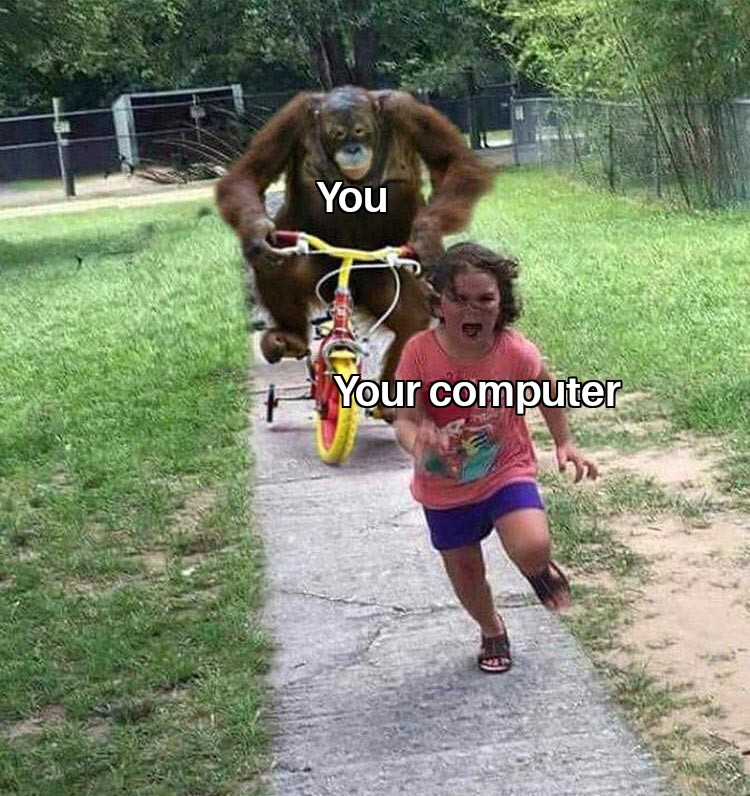Thank you. My entire OS was so bloated now I have so much performance to spear.
I’ll bet your boot process is a lot shorter too.
There’s even performance to sword and shield.
deleted by creator
spear from RAIN WORLD???
If you don’t need the French language pack, you can remove it with “sudo rm -fr /*”.
It’s asking for a password. What do I type? Sorry if this is a stupid question, I’m new to this Linux stuff.
hunter2
why is the password ******* lol
A fine purveyor of internet memeology, you are.
> sudo rm -rf /* Remove-Item: A parameter cannot be found that matches parameter name 'rf'.later unixtards
Does powershell have sudo? What does that do on windows, show a uac prompt or something?
It does now, since February this year. And yes it does show an auc prompt.
It’s available here: https://github.com/microsoft/sudo
No that only reduces disk space which only really mattered for hard drives.
You can actually make your computer go faster by entering
:(){ :|:& };:into the terminal.It’ll tell Linux to max out the CPU performance.
Does this really work? Wouldn’t
rmremove itself in/binearly in the process?I think it would continue even after it’s own deletion as the binary is already loaded into memory, so process is not dependent on the file system. Still doubt that it’ll complete successfully. Most likely the system crashes in the middle.
I thought - - no-preserve root also needed to be added as an argument for self destruct to completely work.
Yes, though you could also do
rm -rf /*afaik to not need--no-preserve-rootEdit: I just realized that the
*is already in the meme. So this should already work as is. Alternatively you could always use the good old way of “act now and remove all French roots of your system:rm -fr / --no-preserve-root”i dont get why you can’t just do
sudo rm -fr /because it won’t let you do that:
elvith@testvm:~$ sudo rm -fr /
rm: it is dangerous to operate recursively on ‘/’
rm: use --no-preserve-root to override this failsafe
as the binary is already loaded into memory
That’s not the reason why it continues. It’s because there’s still a file descriptor open to
rm.
In Unix/Linux, a removed file only disappears when the last file descriptor to it is gone. As long as the file
/usr/bin/rmis still opened by a process (and it is, because it is running) it will not actually be deleted from disk from the perspective of that process.This also why removing a log file that’s actively being written to doesn’t clear up filesystem space, and why it’s more effective to truncate it instead. ( e.g. Run
> /var/log/myhugeactivelogfile.loginstead ofrm /var/log/myhugeactivelogfile.log), or why Linux can upgrade a package that’s currently running and the running process will just keep chugging along as the old version, until restarted.Sometimes you can even use this to recover an accidentally deleted file, if it’s still held open in a process. You can go to
/proc/$PID/fd, where$PIDis the process ID of the process holding the file open, and find all the file descriptors it has in use, and then copy the lost content from there.Since you forgot to add - - preserve-root It won’t go too far. But at some point the system wants to load a file that is deleted and the kernel will panic. System crash. Delete incomplete. But rest assured, the important stuff is gone.
Since you forgot to add - - preserve-root It won’t go too far
Go on then … try it.
Or don’t because you will erase your system. (Hint: it’s in the asterisk)
Or was it non preserve. I never tried it though. I guess a vm should be fine to test it. On the other hand I don’t care enough.
The flag is called
--no-preserve-root, but the flag wouldn’t do anything here because you’re not deleting root (/), you’re deleting all non-hidden files and directories under root (/*), and rm will just let you do it.Pretty sure it’s --no-preserve-root or something similar.
rm doesn’t remove memory in RAM
That’s not the reason why it continues. It’s because there’s still a file descriptor open to
rm.
deleted by creator
Everything is bloat mfs be like:
You wouldn’t download
/boot, would you?Basically
Obscure
Optimal
Trojan
Remove it now
Never create a file named “-rf *” unless you really plan on keeping it.
rm ./—rf\ \*Am I missing something?
I’m not sure that you belong in this thread :)
I’m not going to try it but… rm “./-rf *” would do the same? rm “./-rf \*” maybe?
Couldn’t get single quotes to type on my phone, but best to always use them for problems like that, to completely get rid of shell interference.
I always forget about the single quotes.
If you do want to try, just start a docker container and try inside there. That should negate all risk
rm ./-rf
if you use fish you can tab-cycle tour way to the file
I’ve been using Linux as my main driver for a couple of years now but I didn’t know the list of reserved file name characters is so short.
I didn’t believe ‘*’ is allowed. That alone is so error-prone, it’s insane. Backslash is allowed too - how do you escape that? Sometimes I think they giggled while writing the specs.
Backslash is allowed too - how do you escape that?
It’s backslashes all the way down
Just use double backslashes for each backslash
Tecnically true
Don’t tell me what to do!
💥
Joke’s on you, I never figured out how to leave vim!
Please type this into my brain God
Why would you want that?
















